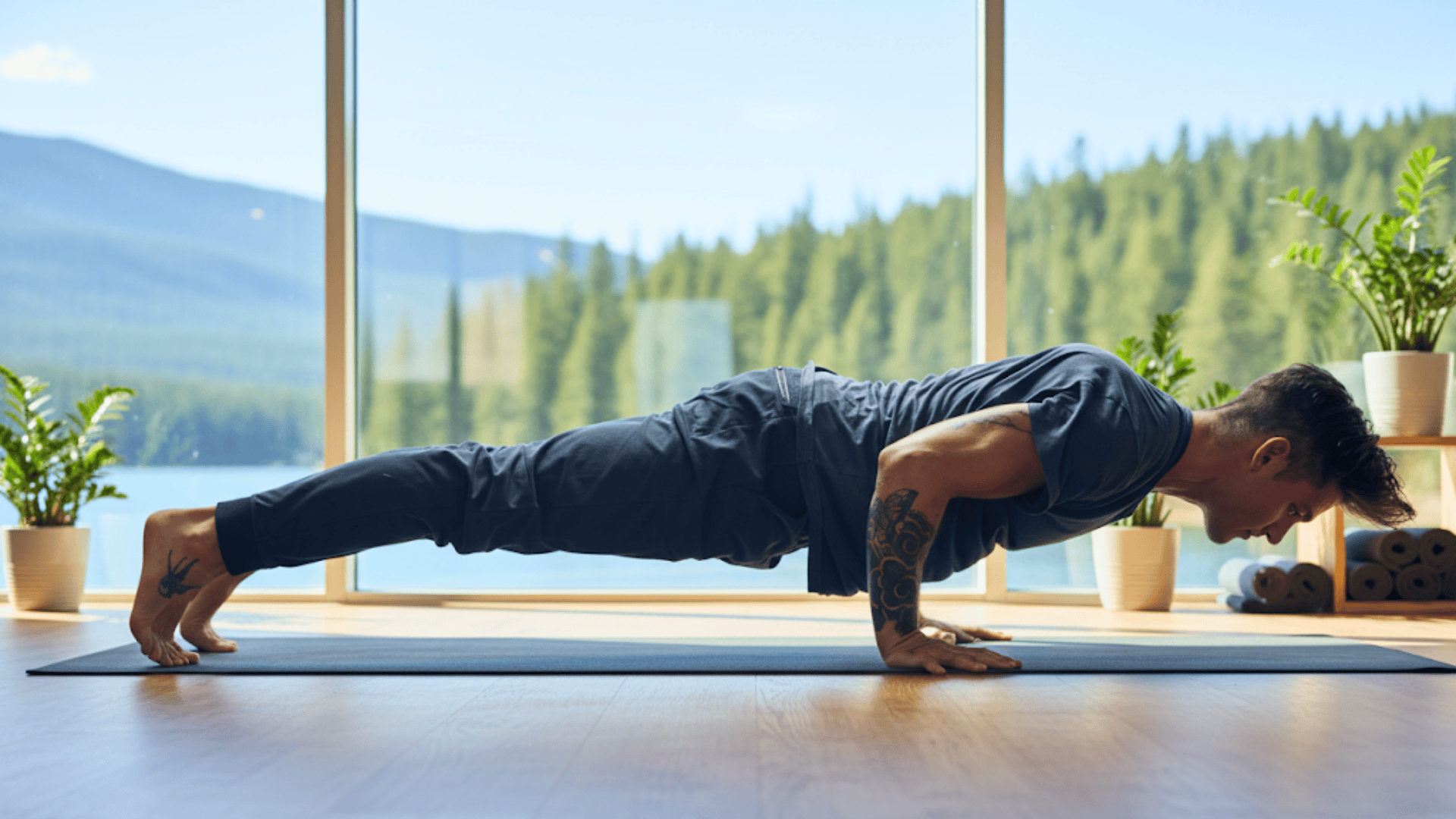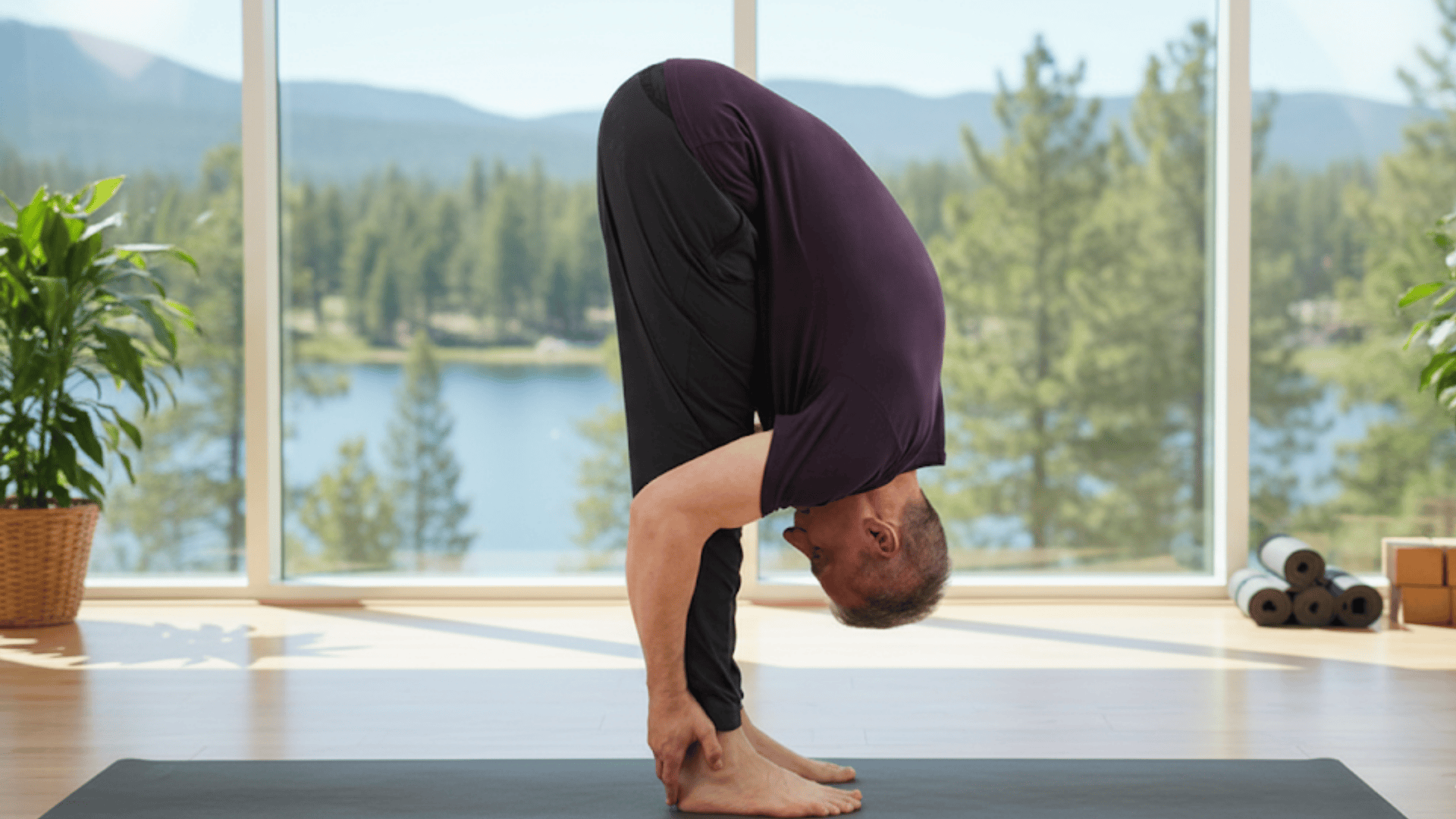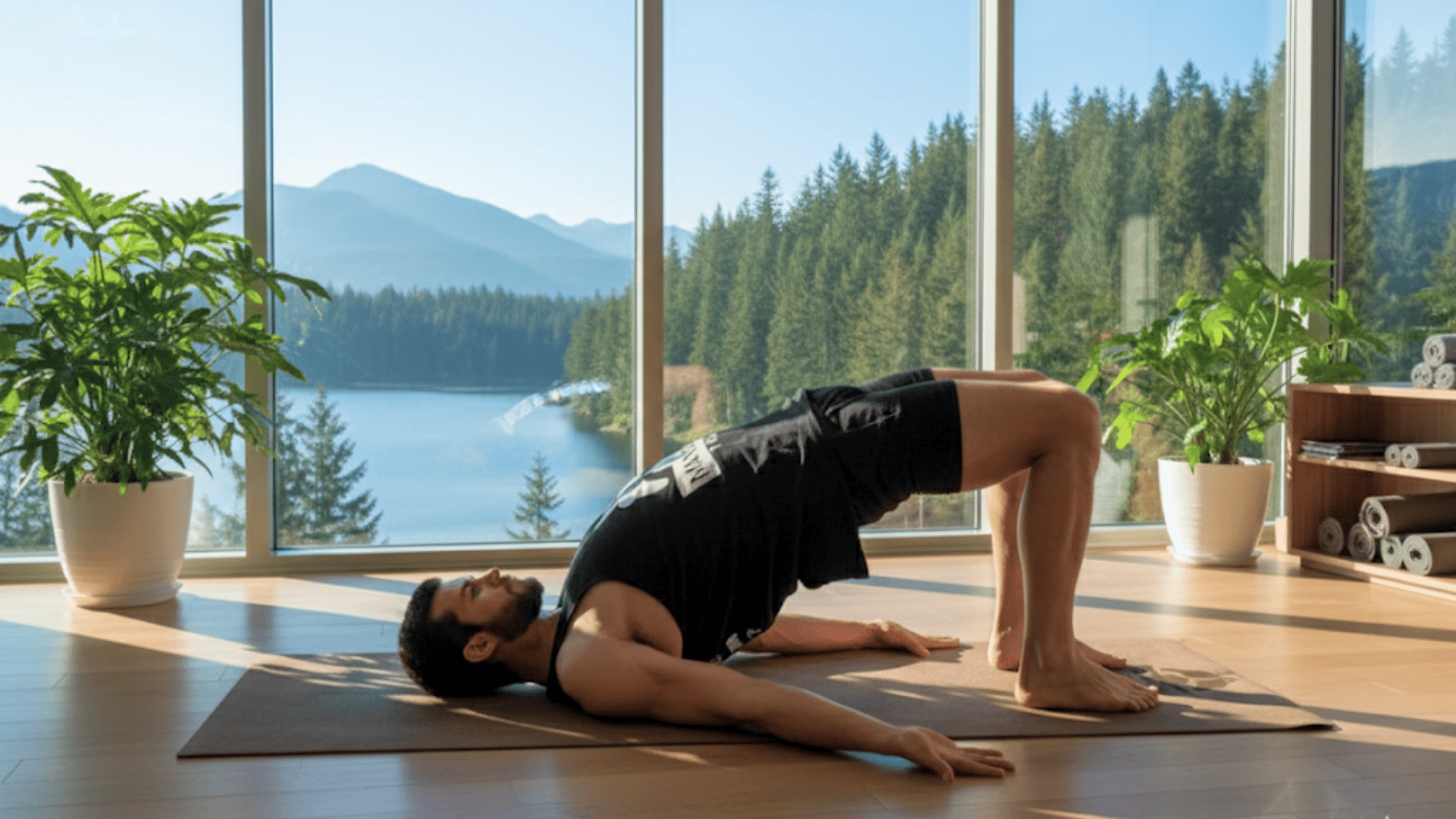I’ve seen how often tight muscles, stiff joints, and nagging soreness slow men down, even those who train hard and stay consistent. That’s what led me to look into yoga for men as more than just stretching.
It’s a solid way to support strength training, improve mobility, and help the body recover faster. Yoga doesn’t take away from your routine as it adds to it in a way that makes sense.
If you’re feeling tight after workouts, dealing with pain that won’t go away, or just want to move better, this guide is for you. You’ll learn how to start, which poses actually help, and how just a little yoga can make a big difference in your performance and how you feel each day.
Why Men Should Consider Yoga
Many men still think yoga is just stretching, but it’s much more than that. It’s a practical way to build strength, improve flexibility, and calm your mind without needing extra equipment or a gym.
If you sit at a desk, lift weights, or play sports, yoga can help you undo tightness in your hips, shoulders, and back. This means you’ll move better, recover faster, and feel less stiff during everyday activities.
Yoga also gives you a mental break. By focusing on your breath and movements, you lower stress, improve concentration, and return to your day feeling sharper and more relaxed.
Benefits of Yoga Tailored for Men
Here’s what yoga can actually do for you:
Build Real Strength: Forget the idea that yoga is just stretching. Holding your body weight in poses like plank, warrior III, or crow pose will light up muscles you didn’t even know you had.
Unlock Your Body’s Potential: Many men carry tension in their hips, shoulders, and hamstrings due to sitting at desks or engaging in repetitive workouts. Yoga systematically opens up these tight spots, which means better performance in the gym, on the field, or just getting out of bed without groaning.
Sharpen Your Mind: Between work stress, family responsibilities, and everything else, your brain needs a break. Yoga forces you to focus on your breath and body, which naturally calms your nervous system.
Fix Your Posture: Hours hunched over computers create rounded shoulders and forward head posture. Yoga strengthens your back muscles and opens your chest, helping you stand taller and move with more confidence.
Prevent Injuries: Tight muscles are prone to injury. By improving your flexibility and body awareness, yoga helps prevent those annoying strains and tweaks that can sideline you from activities you love.
Yoga Workouts For Men Every Man Should Know
Yoga is an excellent way for men to build strength, flexibility, balance, and mental focus. Below are some effective poses you can incorporate into your routine.=:
1. Chair Pose (Utkatasana)

This powerful standing pose engages your thighs, glutes, and abdominal muscles while activating the shoulders and arms.
Holding the position builds stamina, improves posture, and strengthens the lower body. It’s especially effective for developing endurance and stability in everyday movement.
2. Warrior II (Virabhadrasana II)

Warrior II is excellent for building leg strength and stability while opening the hips. It stretches the inner thighs, engages the arms, and boosts endurance.
Practicing regularly helps improve balance, coordination, and focus while grounding the body in a strong, athletic stance. This approach has also become a specific differentiator in the fitness world, especially among yoga men who value both strength and flexibility.
3. Plank to Chaturanga Flow

This sequence transitions from a plank into a controlled low push-up, working the chest, triceps, shoulders, and core.
It challenges upper body strength and endurance while engaging stabilizing muscles. The flow also builds mental focus and prepares the body for advanced postures.
4. Boat Pose (Navasana)

The boat pose strengthens the abdominal muscles, hip flexors, and spine while improving balance and concentration.
Holding this pose requires stability and controlled breathing, which enhances endurance. It’s a highly effective core exercise that also supports better posture and reduces lower back strain.
5. Mountain Pose (Tadasana)

Often seen as a “simple” standing position, Mountain Pose develops awareness of proper alignment and balance. It strengthens the thighs, knees, and ankles while engaging the core.
Practicing this pose regularly improves posture, steadiness, and body awareness for daily movement.
6. Standing Forward Bend (Uttanasana)

This deep stretch targets the hamstrings, calves, and spine while calming the nervous system. It relieves tension in the lower back and improves flexibility in the legs.
Regular practice can counteract tightness from sitting and support better mobility in athletic performance.
7. Bridge Pose (Setu Bandhasana)

The bridge pose works the glutes, hamstrings, and lower back while opening the chest and shoulders. It helps strengthen the posterior chain, improve spinal flexibility, and stimulate circulation.
This pose is great for countering stiffness from long sitting hours or heavy workouts.
Focused Yoga Programs for Men You Can Follow
Build structure into your practice with these trusted programs designed to help men gain strength, mobility, and focus.
1. Man Flow Yoga
This program is built specifically for men and focuses on strength, mobility, and recovery rather than flexibility tricks. It offers hundreds of on-demand video sessions and structured challenges you can follow at your own pace.
2. Yoga for Guys
Designed for men who lift, run, or play sports, Yoga for Guys provides short routines to open tight hips and shoulders, improve posture, and build functional strength. The sessions complement your gym or field workouts and are easy to fit into busy schedules.
3. Yoga4Men 200-Hour Teacher Training
This professional, Yoga Alliance-certified program is tailored specifically for men, focusing on asana alignment, breathwork, meditation, and anatomy.
It offers comprehensive training and certification for men seeking a structured, authorized yoga practice or teaching qualification.
Yoga Morning Routines
These are short, energizing sequences designed to wake up your body and mind. Perfect for busy schedules, they take only 10–15 minutes but leave you feeling more alert and loose than any cup of coffee.
Gentle twists, forward folds, and light stretches help improve circulation and shake off morning stiffness. Done consistently, morning yoga can boost your mood, sharpen focus, and set a positive tone for the rest of your day.
A weekly schedule example:
| Day | Workout Plan |
|---|---|
| Monday | Weight training + 10 minutes post-workout yoga |
| Tuesday | Full 30-minute yoga session |
| Wednesday | Cardio and light stretching |
| Thursday | Weight training + 10 minutes yoga |
| Friday | Rest or gentle yoga |
| Weekend | Longer yoga session or active recovery |
Sample Yoga Workouts for Men
Here are simple sequences combining the poses above into effective routines that balance strength, flexibility, and recovery:
Beginner Full-Body Routine (15 minutes)
Start here if you’re new to yoga or want a simple full-body flow. This routine warms up your spine, strengthens key muscles, and ends with gentle stretches so you feel loose and relaxed.
- Mountain Pose (1 minute): Stand tall with feet hip-width apart, arms by your sides. Breathe deeply to center yourself and engage your core.
- Forward Fold (1 minute): Hinge at the hips, fold forward, and let your arms dangle. Gently sway side to side to stretch your hamstrings and release your back.
- Chair Pose (30 seconds): Bend your knees, sit back like in a chair, arms reaching overhead. This fires up your thighs, glutes, and core.
- Warrior II (1 minute each side): Step your feet wide, front knee bent, arms extended. Builds leg strength, opens hips, and improves focus.
- Bridge Pose (1 minute): Lie on your back, knees bent, lift hips up. Strengthens glutes and lower back while opening your chest.
- Child’s Pose (2 minutes): Kneel, sit back on your heels, stretch arms forward. A gentle rest that stretches your spine and shoulders.
- Seated Forward Fold (2 minutes): Sit with legs straight, hinge forward from the hips, and reach for the feet or shins. Deep hamstring and lower back stretch.
- Easy Seated Twist (1 minute each side): Sit cross-legged, twist gently toward one knee. Helps with spinal mobility and digestion.
- Final Relaxation (3 minutes): Lie flat, arms and legs relaxed. Focus on slow breathing to end the session calm and refreshed.
This sequence takes only 15 minutes and leaves your body feeling balanced and energized.
Power Flow Circuit (20 minutes)
Use this circuit when you want more intensity. It combines strength moves and balance poses to challenge your muscles and keep your heart rate up.
- Downward Dog (1 minute): From hands and knees, lift hips up to form an inverted V. Strengthens arms and legs while lengthening your spine.
- Step Forward to Forward Fold (30 seconds): Step one foot forward between your hands, then fold over your legs. Opens hips and stretches hamstrings.
- Chair Pose (30 seconds): Sit back into the pose with arms raised. Engages thighs, glutes, and shoulders.
- Warrior I (1 minute each side): Lunge forward with back foot at an angle, arms reaching up. Builds strength and balance in legs and core.
- Side Plank (30 seconds each side): From a plank, rotate to one side, stacking feet. Strengthens obliques, shoulders, and stabilizers.
- Child’s Pose (1 minute): Kneel back to reset, stretch your spine, and slow your breath between rounds.
This flow is great as a stand-alone workout or after a short cardio session.
Flexibility Focus (25 minutes)
Perfect for recovery days or after tough workouts, this flow targets tight hips, hamstrings, and back muscles while calming your nervous system.
- Cat/Cow Stretches (3 minutes): On hands and knees, alternate arching and rounding your spine. Improves flexibility and warms up the back.
- Hip Circles in Tabletop (2 minutes): From hands and knees, circle one knee outward then inward. Loosens hips and improves mobility.
- Pigeon Pose (3 minutes each side): Bring one shin forward, extend the other leg back. Deeply opens hips and glutes.
- Seated Spinal Twist (2 minutes each side): Sit with one leg bent over the other, twist gently toward the bent knee. Increases spinal rotation and relieves tension.
- Hamstring Stretch (3 minutes each side): Sit or stand with one leg extended, fold forward. Lengthens hamstrings and calves.
- Chest Opener (3 minutes): Interlace fingers behind your back or hold a strap, lift arms gently. Counters rounded shoulders from desk work.
- Legs Up the Wall (5 minutes): Lie on your back with legs extended up a wall. Promotes circulation, relieves tired legs, and helps you relax deeply.
This sequence helps you reset your body and mind, making it easier to bounce back for your next workout.
Combining Yoga With Other Fitness Practices
Yoga works really well with many types of exercise. It’s not meant to take the place of your main workouts; it just helps them work better. For example, if you lift weights, doing yoga on your rest days or immediately after can help loosen tight muscles and improve your body’s overall feel the next day.
Just 15–20 minutes of stretching can make a big difference.
Many studios now offer men’s yoga sessions that blend Pilates and yoga for strength and flexibility.
If you run, yoga can help with common tight spots like your hips, hamstrings, calves, and IT bands. Even a short 10-minute session after your run can help prevent injuries.
For people who play sports, yoga can improve balance, body control, and focus. These things help you move better on the court or field and may even help you avoid injuries.
Swimmers can use yoga to open up the shoulders and strengthen their breathing. Cyclists often deal with tight hips and sore backs; yoga helps with both. Even after high-intensity workouts like HIIT or cardio, yoga helps the body cool down, stretches the muscles, and calms the mind.
By adding yoga into your weekly routine, even in small amounts, you can improve how your body moves, how fast you recover, and how focused you feel. It fits in almost anywhere and gives your workouts a healthy boost.
Common Mistakes Men Should Avoid in Yoga
Even though yoga is beginner-friendly, it’s easy to fall into habits that slow progress or cause frustration. Keeping these in mind will help you stay consistent and injury-free.
- Skipping warm-ups: Going straight into deep stretches can strain tight muscles. Start with light movements first.
- Forcing flexibility: Don’t push too hard or fast. Focus on alignment and gradual progress.
- Holding your breath: Controlled breathing supports endurance, strength, and relaxation.
- Ignoring props: Blocks and straps make poses safer and more effective, not easier.
- Comparing yourself to others: Everybody is different. Measure progress against yourself, not classmates.
- Rushing the process: Yoga results come from consistency, not quick fixes.
By steering clear of these mistakes, you’ll build a stronger foundation and actually enjoy the benefits yoga has to offer. With that in mind, let’s wrap it up.
Wrapping It Up
I’ve watched the benefits of yoga for men show up in real ways: less pain, better movement, quicker recovery. At first, it didn’t seem like something that would matter much for men who already lift, run, or play sports.
But over time, I saw how it filled the gaps most workouts leave behind. It helped build stability, improve focus, and support the body in ways that heavy training alone couldn’t.
Now it’s your turn to try it. You don’t need to change your routine or spend hours on a mat. Just start small. A few poses after your workout or on rest days can make a real difference. Your body will feel the shift, and once you do, it’s something you’ll want to keep.
Want more tips like this? Check out the other yoga blogs on the site and keep learning what works.





